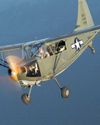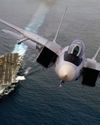ROYAL NAVY WILDCATS
Flight Journal
|May - June 2025
Grumman's carrier-based fighter excels in His Majesty's Service

"I would still assess the Wildcat as the outstanding naval fighter of the early years of World War II ... I can vouch as a matter of personal experience that this Grumman fighter was one of the finest shipboard aeroplanes ever created."-British Royal Navy Captain Eric “Winkle” Brown, CBE, DSC, AFC
 First Wildcats (“Martlets”)
First Wildcats (“Martlets”)At the onset of World War II, the British Royal Navy's Fleet Air Arm (FAA) had only 232 frontline aircraft on its strength. By 1940, the FAA was in desperate need of a modern carrier-capable fighter to replace and supplement the largely obsolete aircraft in service. Fortunately, the U.S. company Grumman was willing and able to step up to provide their rugged and pugnacious F4F Wildcat to the British. This was the start of a long and successful trend for the Royal Navy (RN) to operate U.S. aircraft during WW II, mostly under the Lend-Lease scheme. Subsequently, the RN also used Vought F4U Corsairs, Grumman Avengers, and Grumman F6F Hellcats.
For the RN in 1940, the F4F was a simple modern design, robust and with performance far ahead of anything the FAA possessed at that time. Best of all, with the fall of France, Belgium, and Greece, large numbers of these aircraft on order for those countries were immediately available. These aircraft, modified versions of the U.S. Navy's F4F designated the Grumman Model G-36A by the manufacturer, became the RN's first high-performance single-seat monoplane, carrier-capable fighters. In service with the RN, the F4F Wildcat was renamed the “Martlet” (after a fictional bird used in heraldry).
Esta historia es de la edición May - June 2025 de Flight Journal.
Suscríbete a Magzter GOLD para acceder a miles de historias premium seleccionadas y a más de 9000 revistas y periódicos.
¿Ya eres suscriptor? Iniciar sesión
MÁS HISTORIAS DE Flight Journal

Flight Journal
ELLIPTICAL ELEGANCE
Flying and evaluating the Seafire Mark III
4 mins
November - December 2025

Flight Journal
IRON DOG
Fighting the Pacific and the P-39 at the same time
14 mins
November - December 2025

Flight Journal
Fighter Pilots: A Warrior Clan
TAKE A HARD LOOK at the two young men in these photos. Do they look as if they were bent on killing one another? On the left we have a young, unknown enlisted Japanese pilot standing in front of a Nakajima Ki-27 \"Nate,\" one of Japan's earliest monoplanes that led to the much vaunted Zero.
3 mins
November - December 2025

Flight Journal
KEN WALSH THE FIRST CORSAIR ACE
Medal of Honor pilot's combat adventures
12 mins
November - December 2025

Flight Journal
Big Chief's Little Chief
Thunderbolt action with the Wolf Pack
11 mins
November - December 2025

Flight Journal
ENEMY PILOTS SPEAK Voices from the other side
All too often American students of air warfare forget that enemy aircraftwhether Messerschmitts or MiGs-were flown by human beings with the same motivations and traits as Allied airmen. More often than not, the only difference between friend and foe was the paint on the airplane and where they landed. Therefore, we've assembled a variety of accounts from WW II Axis fighter pilots, men who were more than simply targets.
11 mins
November - December 2025

Flight Journal
FLYING THE FW 190
A legend gets checked out in the Butcher Bird
15 mins
November - December 2025

Flight Journal
DOUBLE-THEATER ACE
The fearless missions of legendary fighter pilot Col. John D. Landers
12 mins
November - December 2025

Flight Journal
WARBUG IN THE PACIFIC
Surviving combat in a Stinson OY-1/L-5
10 mins
September - October 2025

Flight Journal
WINGS OF THE FLEET
Celebrating the U.S. Navy's 250-year legacy
9 mins
September - October 2025
Listen
Translate
Change font size

